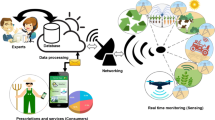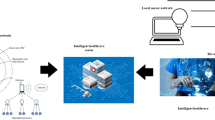Abstract
With the expansion in the use of IoT, increasing the efficiency of these networks has become even more significant. Objects need reliable communications at suitable speed to be able to reach the expected performance. In a heterogeneous network of IoT, the objects can include users and related devices. Despite the hybrid Li-Fi and Wi-Fi networks, IoT needs were somewhat met. However, the efficiency of these networks depends on the choice of access points at the network level. In this study, a new algorithm was proposed based on the access point selection model, considering the strategic behavior of the objects and users. In this algorithm, inspired by access point selection model, a new adaptive algorithm was selected by choosing the access point by Markov game to enhance the load balancing and efficiency in IoT networks based on Wi-Fi and Li-Fi combination. According to the simulation results, it is seen that the proposed method could greatly increase the efficiency of IoT network and better distributes network load between access points with different technology. Overall network throughput was estimated at an average of at least 10% compared to the load-balancing method with fuzzy logic approach proposed in before research.











Similar content being viewed by others
References
Wang Y, Haas H (2015) Dynamic load balancing with handover in hybrid Li-Fi and Wi-Fi networks. J Lightwave Technol 33(22):4671–4682
Tsonev D, Stefan V, Harald H (2014) “Light fidelity (Li-Fi): towards all optical networking.” broadband access communication technologies VIII. Int Soc Optics Photon 9007:627
Harald H, Liang Y, Yunlu W and Cheng C (2015) What is Li-Fi?’ Journal Of Lightwave Technology; 2015 IEEE
Tsonev D, Videv S, Haas H (2013) Light fidelity (Li-Fi): towards all optical networking. In: Proc. SPIE 9007, Broadband Access Communication Technologies VIII, 900702 (1 February 2014). https://doi.org/10.1117/12.2044649
Wu X, Majid S, Harald H (2017) Access point selection for hybrid Li-Fi and Wi-Fi networks. IEEE Trans Commun 65:5375–5385
Li X, Zhang R, Hanzo L (2015) Cooperative load balancing in hybrid visible light communications and Wi-Fi. IEEE Trans Commun 63(4):1319–1329
Wang Y, Dushyantha AB, and Harald H (2015) "Dynamic load balancing for hybrid Li-Fi and RF indoor networks." Communication Workshop (ICCW), 2015 IEEE International Conference on. IEEE
Hansen CJ (2011) WiGiG: Multi-gigabit wireless communications in the 60 GHz band. IEEE Wireless Commun 18(6):6–7
Wu X et al (2016) "Two-stage access point selection for hybrid VLC and RF networks." Personal, Indoor, and Mobile Radio Communications (PIMRC), 2016 IEEE 27th Annual International Symposium on. IEEE
Hasan MK, et al (2018) "Fuzzy logic based network selection in hybrid OCC/Li-Fi communication system." 2018 Tenth International Conference on Ubiquitous and Future Networks (ICUFN). IEEE
Souri A et al (2019) A systematic review of IoT communication strategies for an efficient smart environment. Trans Emerg Telecommun Technol 6:e3736
Murugaveni S, Mahalakshmi K (2020) Optimal frequency reuse scheme based on cuckoo search algorithm in Li-Fi fifth-generation bidirectional communication. IET Commun 14(15):2554–2563
Etemadi M, Ghobaei-Arani M, Shahidinejad A (2020) Resource provisioning for IoT services in the fog computing environment: An autonomic approach. Comput Commun 161:109–131
Le S-P et al (2020) Enabling wireless power transfer and multiple antennas selection to IoT network relying on NOMA. Elektronika ir Elektrotechnika 26(5):59–65
Liu W-Y et al (2011) An approach for multi-objective categorization based on the game theory and Markov process. Appl Soft Comput 11(6):4087–4096
Hao, J et al (2015) "An Adaptive Markov Strategy for Effective Network Intrusion Detection." Tools with Artificial Intelligence (ICTAI), 2015 IEEE 27th International Conference on. IEEE
Wang X, Tuomas S (2003) Reinforcement learning to play an optimal Nash equilibrium in team Markov games. Adv Neural Inf Process Syst 15:1603–1610
Lei C, Ma D-H, Zhang H-Q (2017) Optimal strategy selection for moving target defense based on Markov game. IEEE Access 5:156–169
Stefan I, Burchardt H, and Haas H (2013) “Area Spectral Efficiency Performance Comparison between VLC and RF Femtocell Networks,” in Communications (ICC), 2013 IEEE International Conference on, pp. 3825–3829
Forecast, Global Mobile Data Traffic (2019) "Cisco Visual Networking Index: Global Mobile Data Traffic Forecast Update, 2017–2022." Update 201
Wang Y, Xiping W, Harald H (2015) "Distributed load balancing for Internet of Things by using Li-Fi and RF hybrid network." Personal, Indoor, and Mobile Radio Communications (PIMRC), 2015 IEEE 26th Annual International Symposium on. IEEE
Littman ML (1994) "Markov games as a framework for multi-agent reinforcement learning." Machine Learning Proceedings 1994. 157–163
Anbalagan S et al (2020) SDN-assisted efficient LTE-Wi-Fi aggregation in next generation IoT networks. Future Gener Computer Syst 107:898–908
Zhang W, Yu K, Wang W, Li X (2021) A self-adaptive ap selection algorithm based on multiobjective optimization for indoor WiFi positioning. IEEE Int Things J 8(3):1406–1416. https://doi.org/10.1109/JIOT.2020.3011402
Mitate, S, et al (2021) "Wireless System selection with spectrum database for IoT." 2021 International Conference on Information Networking (ICOIN). IEEE,
Priya B, Malhotra J (2021) QAAs: QoS provisioned artificial intelligence framework for AP selection in next-generation wireless networks. Telecommun Syst 76(2):233–249
Author information
Authors and Affiliations
Corresponding author
Additional information
Publisher's Note
Springer Nature remains neutral with regard to jurisdictional claims in published maps and institutional affiliations.
Rights and permissions
About this article
Cite this article
Porkar Rezaeiye, P., Sharifi, A., Rahmani, A.M. et al. Access point selection in the network of Internet of things (IoT) considering the strategic behavior of the things and users. J Supercomput 77, 14207–14229 (2021). https://doi.org/10.1007/s11227-021-03788-3
Accepted:
Published:
Issue Date:
DOI: https://doi.org/10.1007/s11227-021-03788-3




